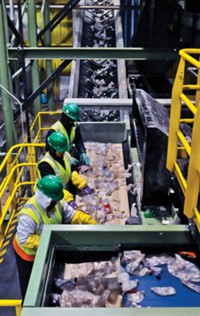Advertisement
Grab your lab coat. Let's get started
Welcome!
Welcome!
Create an account below to get 6 C&EN articles per month, receive newsletters and more - all free.
It seems this is your first time logging in online. Please enter the following information to continue.
As an ACS member you automatically get access to this site. All we need is few more details to create your reading experience.
Not you? Sign in with a different account.
Not you? Sign in with a different account.
ERROR 1
ERROR 1
ERROR 2
ERROR 2
ERROR 2
ERROR 2
ERROR 2
Password and Confirm password must match.
If you have an ACS member number, please enter it here so we can link this account to your membership. (optional)
ERROR 2
ACS values your privacy. By submitting your information, you are gaining access to C&EN and subscribing to our weekly newsletter. We use the information you provide to make your reading experience better, and we will never sell your data to third party members.
Business
Polylactic Acid Redux
Under Cargill ownership, NatureWorks, the maker of polylactic acid, is staging a comeback
by Alexander H. Tullo
February 28, 2005
| A version of this story appeared in
Volume 83, Issue 9
In early 2000, the Cargill Dow joint venture announced that it would build a 300 million-lb-per-year plant in Blair, Neb., making polylactic acid (PLA). The product was going to be the first commodity polymer derived from corn instead of fossil fuels and would herald a new era of biomass materials.
Success was expected to come quickly. The joint venture between Cargill and Dow Chemical said that by the time the plant was completed in 2001, its capacity would be sold out. Thereafter, the partnership would start up a new unit every 18 to 24 months, leading to a global capacity of 1 billion lb by 2006.
Reality, however, turned out to be harsh. Though the Blair plant did start up in 2002, it still isn't sold out, and no new plants have been built. Dow posted a $148 million charge for a Cargill Dow loan guarantee last year and earlier this year sold its stake in the venture to Cargill, which gave it a new name: NatureWorks LLC.
Kathleen M. Bader, former group president of styrenics and engineered products at Dow, took the reins of the joint venture last year, and she is staying on under Cargill. Her goal is to turn NatureWorks around by narrowing its focus to markets where she believes PLA has an advantage, such as packaging and nonwoven fabrics. The company is shelving market development efforts in far-flung applications like injection molding and teabags.
She is also a realist, well aware of other new-to-the-world plastics that flopped, such as Dow's Index ethylene-styrene interpolymer and Shell's Carilon aliphatic polyketone. "Market adoption is slower than we anticipated," Bader says. "Creating a market for a new polymer is not easy; most people fail at it."
And a plastic doesn't get any newer than PLA. It is made via the fermentation of glucose into lactic acid, which is then polymerized to make PLA. The biodegradable polymer is used in plastics applications such as packaging and films, where it competes with polyethylene terephthalate and polystyrene. It is also used in fibers for nonwoven and other fabrics, competing largely with polyester.
PLA has racked up some successes. For example, Biota is selling water in PLA bottles. Newman's Own is using PLA tubs to package organic salads. And Del Monte Fresh Produce is packaging fresh-cut produce in PLA containers.
"We have seen the market adoption begin, but it is largely early adopters and innovators," Bader says. "We need to make the step change of getting the major brand owners who are the large customers. If some of those large brand owners decided to get serious about sustainability and shifted to sourcing a NatureWorks-made product, we would go a long way toward a more environmentally friendly plastic in the market."
Bader expects that the appeal of a plastic that is biodegradable and based on renewable resources will grow in coming years as the public demands a greater commitment to sustainability from corporations. "They are looking for the landscape to change from one where people do the 'eco talk' to one where people do the 'eco walk,' " she says.
However, Edgar Acosta, a PET resin and fiber consultant with Houston-based DeWitt & Co., says being "eco friendly" may not be enough for PLA to succeed. He says it isn't cheaper than PET, giving no financial incentive for plastic processors to switch. "It will be a specialty item looking for a market, and that's where it is today," he says.
In fibers, on the other hand, Acosta says PLA holds some promise because of its compatibility with polyester in blends and because it can be dyed at a much lower temperature than polyester.
NatureWorks contends that PLA is cost-competitive with PET. In addition, Bader says the company is continuing to reduce the cost of the polymer and improve its properties.
Bader points out that PLA production can require only about half of the fossil fuels needed to make conventional plastics, and that's including the energy required to grow and harvest the corn. As the price of oil increases, PLA closes the price gap with other plastics. "There are customers that are adopting PLA, given the significant increase in the price of polystyrene over the last 18 months," she says.
BUT SWITCHING to PLA, she admits, still requires a leap of faith. "It takes someone who is willing to say, 'Look, we don't need perfection; you make a very nice polymer that is young and new and has to continue to evolve, but we're willing to work with you to make that happen.' "
Early adopters can have issues with PLA as well. Eco-friendly clothing supplier Patagonia told customers in 2001 that, although it was excited about the potential of PLA, it is "too good to be true" because it is made, in part, from genetically modified (GM) corn, which could threaten the environment.
Bader calls the "pushback" that PLA has received because of GM concerns "curious," and notes that it is impractical to differentiate GM corn from non-GM corn in the U.S. She says it is an "easy excuse" to not use PLA because it may not be environmentally perfect.
Overall, Bader says, NatureWork's prospects have been improving. Sales increased 40% last year, mostly in plastics, which were 70% of sales and are expected to make up 80% this year.
Bader will not give the exact utilization rate for the Blair plant other than to say that it has "sufficient capacity" to take on new customers. And the company, she notes, can add capacity through enhancement projects rather than by adding a new plant, largely because of an improved fermentation microorganism. "We determined that we can expand the lactic acid plant because our 'bug' is more efficient than we originally planned," she says.
NatureWorks still wants to expand overseas, possibly in Europe, the region that has shown the most enthusiasm for PLA. "Three to four years from now," Bader says, "we will look at not only expansion of Blair, which would be incremental to us, but moving beyond that to a new source." Wisely, perhaps, she isn't making bolder predictions than that.





Join the conversation
Contact the reporter
Submit a Letter to the Editor for publication
Engage with us on Twitter